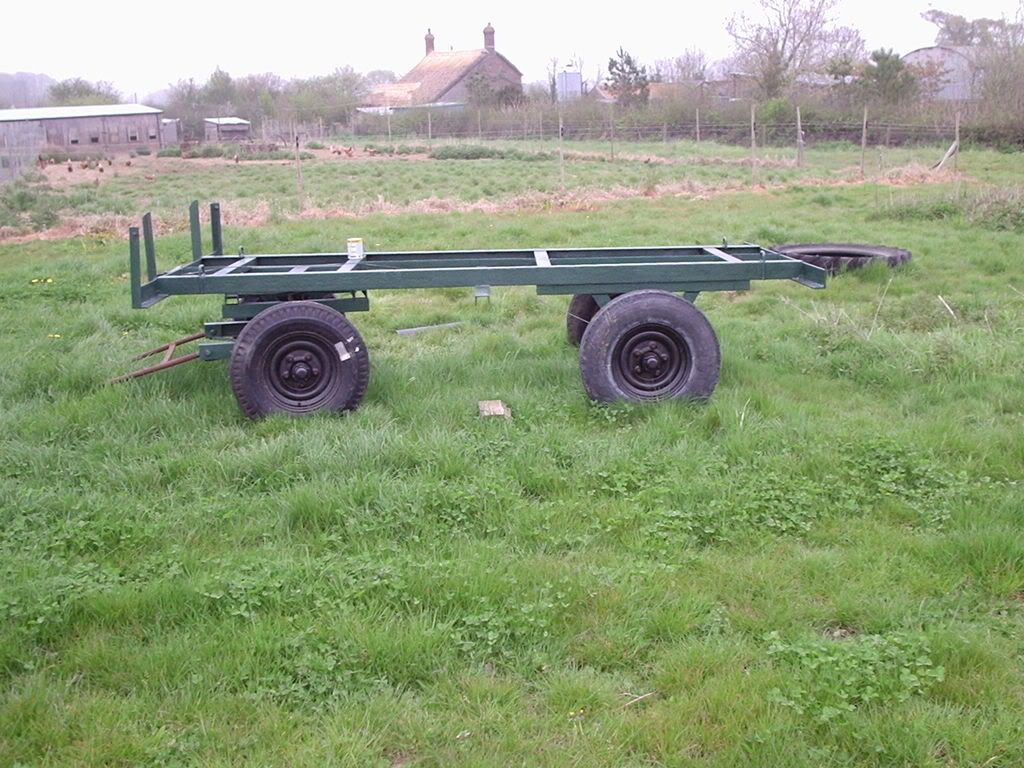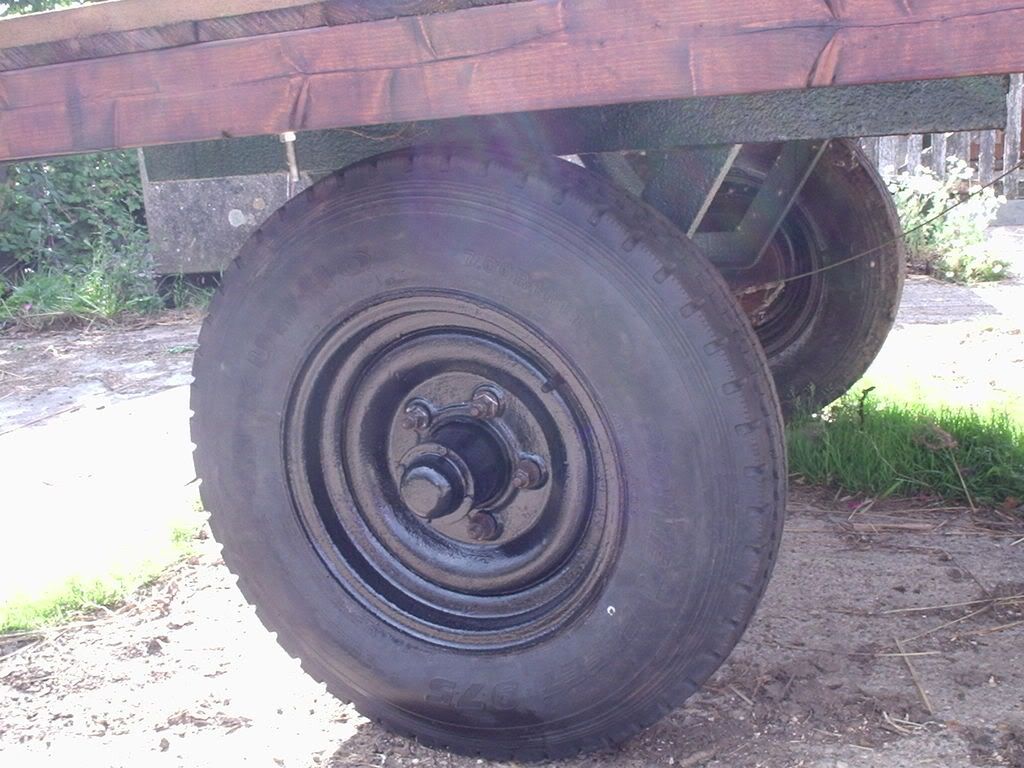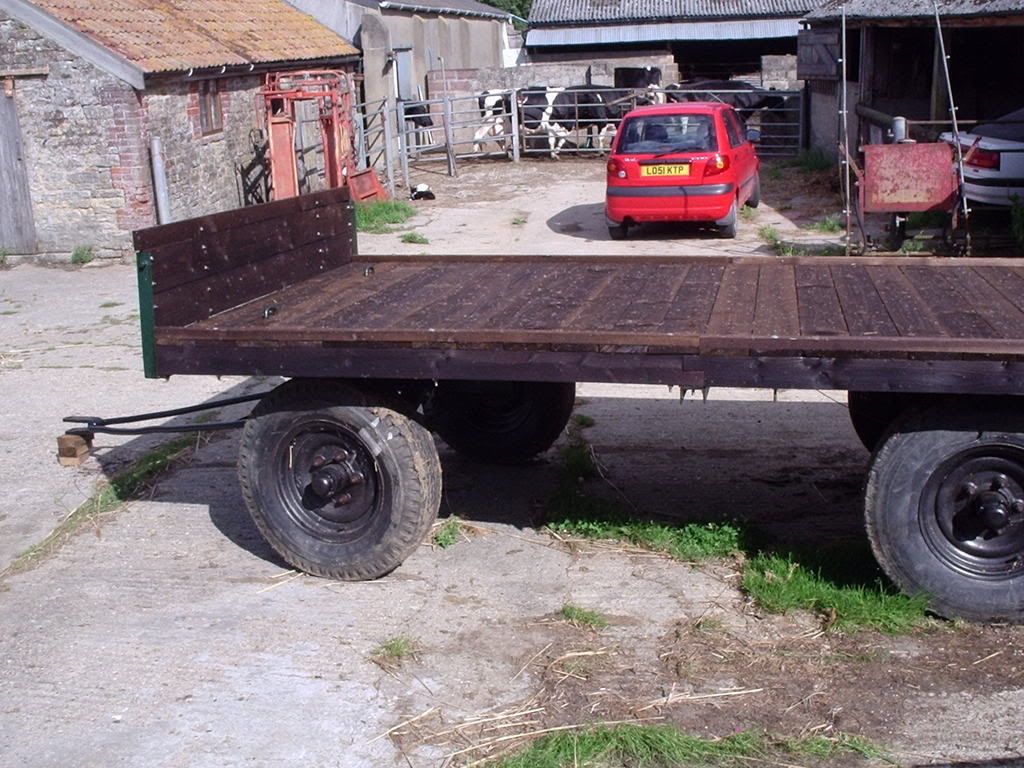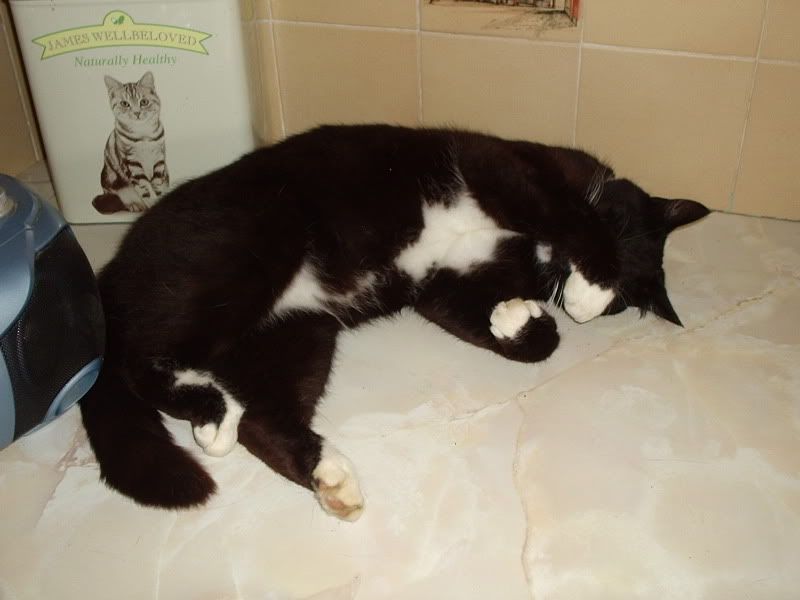Page 1 of 1
Take something old ..
Posted: Sat Nov 21, 2009 1:06 am
by Ian
and make it new again

We had an old trailer sat in one of fields. It had sat there so long that the wheels were half buried in dirt. I had to dig it out. The wood had mostly entirely rotten away. The tyres were totally perished and it was fairly rusted. Most people would have scrapped it. Sadly I don't have a picture of what it looked like sitting there, but heres some 'rebuild' photos. I think it was about 50 years old. You can see it's got a turn table on it. I think it was orignally pulled by a horse and cart.


and the finished one

and heres my cat

enjoy

Posted: Sat Nov 21, 2009 7:29 am
by Huzey
Nice job you have done there Ian. Always satisfying to get something useful from what other people view as scrap. I have got a 3 ton tipper trailer to do after I finish the major.
Nice pussy too, though has he been overcome by paint fumes?

Huzey
Posted: Sat Nov 21, 2009 3:22 pm
by Dandy Dave
The correct term for the turn table is a "Fifth Wheel". Very common on horse drawn vehicles as the teamster could make a sharp turn with it. Just be careful, as if you load it heavy to one side, and make a sharp corner, you could roll it over. Nice job. The wheels and hubs look like they are from a WWII army jeep.

Dandy Dave!
Posted: Sat Nov 21, 2009 7:05 pm
by John
Excellent job. How did you clean up the chassis? Looks a good candidate for having experienced electrolysis in a home-made pool.
Posted: Sat Nov 21, 2009 9:48 pm
by Ian
I used a hammer to bang off all the loose rust, then brushed it down with a wire brush. I used the hammerite direct to rust paint. It's good stuff

I've tried electrolysis before but was never really that satisfied with the results. While it did convert some of the metal oxide back to original metal, the metal seemed to have black coating on it. Maybe I didn't do it exactly right. The other problem with rust is, the metal oxide takes up a larger volume than the metal, so rust sort of bubbles out of the material forever changing it's surface. I think you are just better off hammering the loose off. Plus, not quite sure how I would fit a trailer into a container to do electrolysis on it

electrolytic rust removal
Posted: Sun Nov 22, 2009 12:25 am
by Bensdexta
Ian wrote:I've tried electrolysis before but was never really that satisfied with the results. While it did convert some of the metal oxide back to original metal, the metal seemed to have black coating on it.
The black is magnetite or 'black rust'. It is 'good rust'.

It is harder, more stable and more firmly attached to the substrate that the red rust we all hate. If you don't like the black you can scrub it off or use any chemical rust remover (I have been using as Bilt Hamber Deox) to give a shiny clean iron surface which must be protected immediately.
I like electrolytic rust removal as it is cheap and easy, especially for smaller objects, but keep safe. For best results use a low current for several days. A useful link here:
http://myweb.tiscali.co.uk/andyspatch/rust.htm 
All the best,
Posted: Sun Nov 22, 2009 9:56 am
by Brian
This is where the language difference comes in Dave.

Over here Ian is right, it is called a turntable. Comes from the railways I think, because it is of similar construction to the thing used to turn engines around at the terminus. Turntables sometimes run on ball bearings as in the one used in Doe tractors.
A Fifth Wheel is a totally different beast to us. Over here it refers to something used on trucks to couple articulated trailers. It is a semi floating, horseshoe shaped plate with a set of jaws in the centre to grip the pin mounted on the trailer. The surface of the plate meets up with a plate on the trailer to form a flat surface that allows the truck and trailer to piviot and also flex, there are no ball bearings used.
The jaws in the centre of the plate are locked in place around the pin with a latching mechanism that allows the trailer to be unhitched.
Crane Fruhauf made massive trailers just a few yards from Wrights in Dereham. They made everything from tankers to tank transporters from scratch. Wrights machine shop used to machine the fifth wheel couplings for them. There was also another type in use in the 1950's andthrough to the early 1970's called a Scammel coupling.
Posted: Sun Nov 22, 2009 11:55 am
by henk
Nice trailer Ian.
Must of been a lot of work, but great results.
Brian,
As we are talking about language difference, what’s the different between a lorry and a trailer
Guy's,
Would it be better or worse to use stainless steel as anode at the electrolysis process?
What about the paint that's on the parts during the process? Is it also removed during the process or do you have to remove it before?
Posted: Sun Nov 22, 2009 12:06 pm
by Bensdexta
henk wrote:Would it be better or worse to use stainless steel as anode at the electrolysis process?
NO, don't use stainless steel for the anode as hazardous chromium compounds are produced, hazardous to you and need special disposal.

Use any old piece of mild steel. See the link I posted

henk wrote:What about the paint that's on the parts during the process? Is it also removed during the process or do you have to remove it before?
I just scrap off loose paint first, the electrolysis will remove the rest of the paint.
All the best,
Posted: Sun Nov 22, 2009 1:16 pm
by Brian
Henk,
Lorry is another word for large motorised transport medium

Something we see every day on the roads. We call them lorries. Some people call them trucks and that has come into more common use world wide.
However, a truck used to mean a small four wheeled hand cart used in factories or again on railways where it means a four wheeled, open topped, unit with high sides.
A freight train could be made up of coal tucks for example. Small hand trucks were also used down mines to bring the coal or ore to the lifting cage.
A trailer is something that you "trail behind". What I brought the ploughs on was a trailer. We call everything that can be load carrying and is pulled behind a tractor, car or lorry, a trailer.
Posted: Sun Nov 22, 2009 1:41 pm
by Dandy Dave
Brian wrote:This is where the language difference comes in Dave.

Over here Ian is right, it is called a turntable. Comes from the railways I think, because it is of similar construction to the thing used to turn engines around at the terminus. Turntables sometimes run on ball bearings as in the one used in Doe tractors.
A Fifth Wheel is a totally different beast to us. Over here it refers to something used on trucks to couple articulated trailers. It is a semi floating, horseshoe shaped plate with a set of jaws in the centre to grip the pin mounted on the trailer. The surface of the plate meets up with a plate on the trailer to form a flat surface that allows the truck and trailer to piviot and also flex, there are no ball bearings used.
The jaws in the centre of the plate are locked in place around the pin with a latching mechanism that allows the trailer to be unhitched.
Crane Fruhauf made massive trailers just a few yards from Wrights in Dereham. They made everything from tankers to tank transporters from scratch. Wrights machine shop used to machine the fifth wheel couplings for them. There was also another type in use in the 1950's andthrough to the early 1970's called a Scammel coupling.
Point taken. We also call the plate on a Road Tractor and Tralier combination a fifth wheel, which is a throw back term from the horse drawn wagons that could turn sharply in city steets. The Budwiser Wagon is a well published example. My dad was a horse men and built quite a few of these wagons. He has had as may as 12 horses hitched to a large disk that we had on the farm and drove them. It was not uncommon for him to take a 6 horse hitch to the fair and compete with others. The turn table, or Fifth wheel, that was under these wagons has a series of rollers that aided in it turning easier. Over here, when the truck and trailer combination vehicles started to appear, the wagon builders that built the early trailers kept the term "fifth wheel" and so it has stuck to this day.

Dandy Dave!
Posted: Mon Nov 23, 2009 10:18 pm
by henk
After the electrolysis process has been finished, is the liquid chemical waste or can you flush it trough the drain?
Electrolytic Rust removal
Posted: Tue Nov 24, 2009 12:29 am
by Bensdexta
henk wrote:After the electrolysis process has been finished, is the liquid chemical waste or can you flush it trough the drain?
Yes, so long as you use plain carbon steel for the anode, you can pour the electrolyte (sodium carbonate - household 'washing soda') down the drain when you have finished.
http://www.secondchancegarage.com/publi ... emoval.cfm
All the best,
Posted: Tue Nov 24, 2009 7:58 pm
by henk
This evening I made a test with this material. I used a 12 V battery loader and it gave 2 Amp's. I think I should raise that to 4 Amp's.

Electrolytic rust removal
Posted: Tue Nov 24, 2009 8:59 pm
by Bensdexta
henk wrote:This evening I made a test with this material. I used a 12 V battery loader and it gave 2 Amp's. I think I should raise that to 4 Amp's.
Henk,
2A is plenty for a small part. I usually use less than
0.25A and leave it for several days (see the link I posted earlier). That way you get some pure iron deposited on your part and preserve as much of your part as possible. For best results, the electrolyte should remain clear and still with minimal water movement. If you look carefully you will see the gas bubbles coming off your part. To reduce the current, I just put some auto bulbs in series with the anode.
Keep safe - don't electrocute yourself. Switch off before adjusting

Posted: Tue Nov 24, 2009 9:15 pm
by henk
Thanks for the help Ben,
I will do it outside, so no gas can fill up a space, and electrocute is a danger that I'm aware off, so I will be careful.
Posted: Tue Nov 24, 2009 9:41 pm
by Bensdexta
henk wrote:I will do it outside, so no gas can fill up a space, and electrocute is a danger that I'm aware off, so I will be careful.
I do my electrolysis in the garage, it is good to have some ventilation - I've not had any problems. Another reason to use a low current is hydrogen generation will be slower.
12V DC is not a big voltage but not good across your chest especially for anyone with a heart pacemaker.
Look forward to seeing some of your parts - before & after

All the best,









